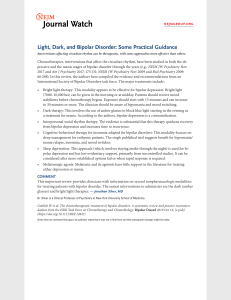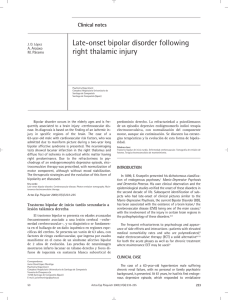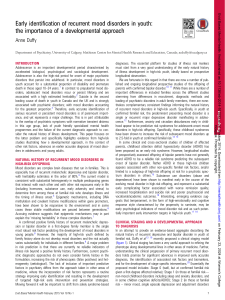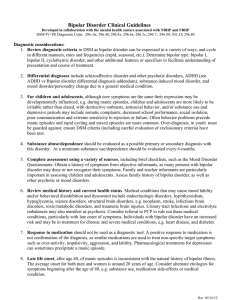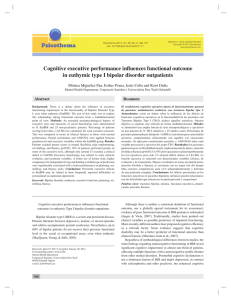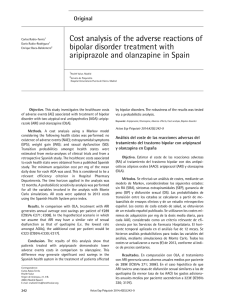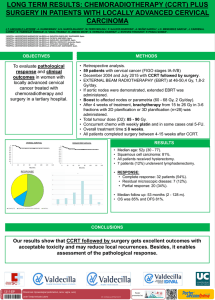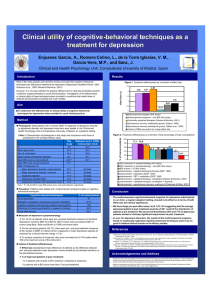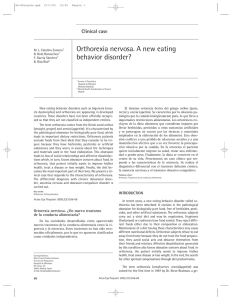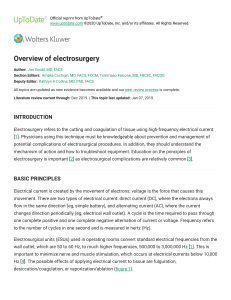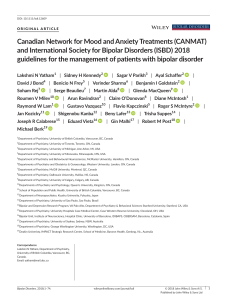Early intervention in Bipolar Disorder: the Jano program at Hospital
Anuncio
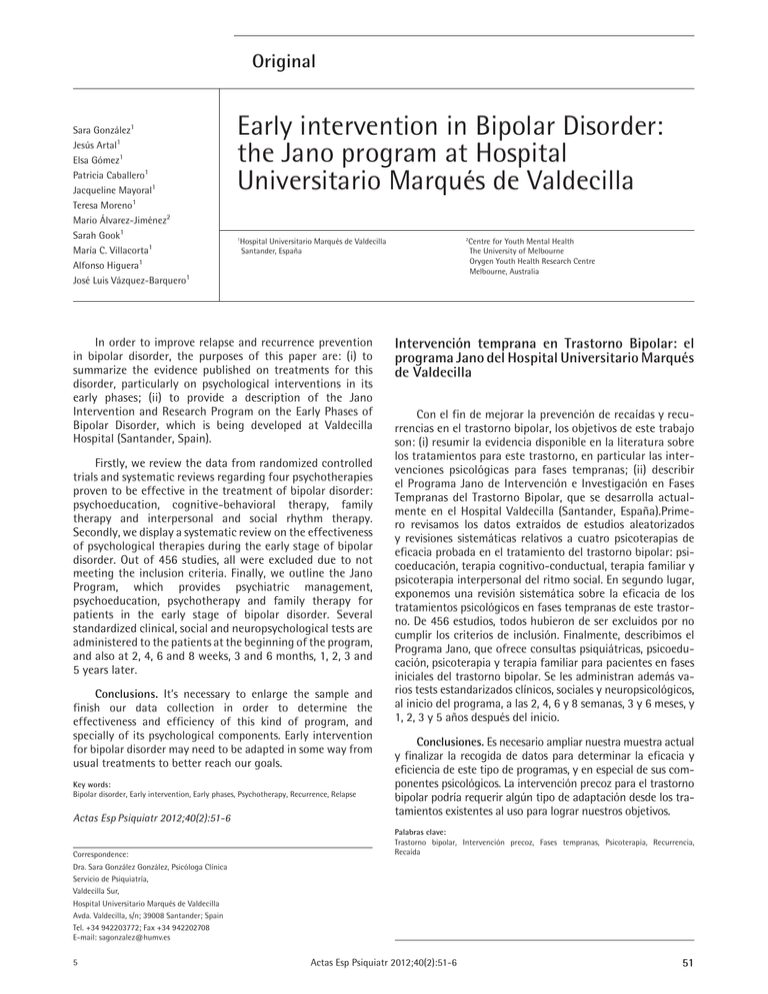
Original Sara González1 Jesús Artal1 Elsa Gómez1 Patricia Caballero1 Jacqueline Mayoral1 Teresa Moreno1 Mario Álvarez-Jiménez2 Sarah Gook1 María C. Villacorta1 Alfonso Higuera1 José Luis Vázquez-Barquero1 Early intervention in Bipolar Disorder: the Jano program at Hospital Universitario Marqués de Valdecilla 1 In order to improve relapse and recurrence prevention in bipolar disorder, the purposes of this paper are: (i) to summarize the evidence published on treatments for this disorder, particularly on psychological interventions in its early phases; (ii) to provide a description of the Jano Intervention and Research Program on the Early Phases of Bipolar Disorder, which is being developed at Valdecilla Hospital (Santander, Spain). Firstly, we review the data from randomized controlled trials and systematic reviews regarding four psychotherapies proven to be effective in the treatment of bipolar disorder: psychoeducation, cognitive-behavioral therapy, family therapy and interpersonal and social rhythm therapy. Secondly, we display a systematic review on the effectiveness of psychological therapies during the early stage of bipolar disorder. Out of 456 studies, all were excluded due to not meeting the inclusion criteria. Finally, we outline the Jano Program, which provides psychiatric management, psychoeducation, psychotherapy and family therapy for patients in the early stage of bipolar disorder. Several standardized clinical, social and neuropsychological tests are administered to the patients at the beginning of the program, and also at 2, 4, 6 and 8 weeks, 3 and 6 months, 1, 2, 3 and 5 years later. Conclusions. It’s necessary to enlarge the sample and finish our data collection in order to determine the effectiveness and efficiency of this kind of program, and specially of its psychological components. Early intervention for bipolar disorder may need to be adapted in some way from usual treatments to better reach our goals. Key words: Bipolar disorder, Early intervention, Early phases, Psychotherapy, Recurrence, Relapse Actas Esp Psiquiatr 2012;40(2):51-6 Correspondence: Dra. Sara González González, Psicóloga Clínica Servicio de Psiquiatría, Valdecilla Sur, Hospital Universitario Marqués de Valdecilla Avda. Valdecilla, s/n; 39008 Santander; Spain Tel. +34 942203772; Fax +34 942202708 E-mail: [email protected] 5 2 Hospital Universitario Marqués de Valdecilla Santander, España Centre for Youth Mental Health The University of Melbourne Orygen Youth Health Research Centre Melbourne, Australia Intervención temprana en Trastorno Bipolar: el programa Jano del Hospital Universitario Marqués de Valdecilla Con el fin de mejorar la prevención de recaídas y recurrencias en el trastorno bipolar, los objetivos de este trabajo son: (i) resumir la evidencia disponible en la literatura sobre los tratamientos para este trastorno, en particular las intervenciones psicológicas para fases tempranas; (ii) describir el Programa Jano de Intervención e Investigación en Fases Tempranas del Trastorno Bipolar, que se desarrolla actualmente en el Hospital Valdecilla (Santander, España).Primero revisamos los datos extraídos de estudios aleatorizados y revisiones sistemáticas relativos a cuatro psicoterapias de eficacia probada en el tratamiento del trastorno bipolar: psicoeducación, terapia cognitivo-conductual, terapia familiar y psicoterapia interpersonal del ritmo social. En segundo lugar, exponemos una revisión sistemática sobre la eficacia de los tratamientos psicológicos en fases tempranas de este trastorno. De 456 estudios, todos hubieron de ser excluidos por no cumplir los criterios de inclusión. Finalmente, describimos el Programa Jano, que ofrece consultas psiquiátricas, psicoeducación, psicoterapia y terapia familiar para pacientes en fases iniciales del trastorno bipolar. Se les administran además varios tests estandarizados clínicos, sociales y neuropsicológicos, al inicio del programa, a las 2, 4, 6 y 8 semanas, 3 y 6 meses, y 1, 2, 3 y 5 años después del inicio. Conclusiones. Es necesario ampliar nuestra muestra actual y finalizar la recogida de datos para determinar la eficacia y eficiencia de este tipo de programas, y en especial de sus componentes psicológicos. La intervención precoz para el trastorno bipolar podría requerir algún tipo de adaptación desde los tratamientos existentes al uso para lograr nuestros objetivos. Palabras clave: Trastorno bipolar, Intervención precoz, Fases tempranas, Psicoterapia, Recurrencia, Recaída Actas Esp Psiquiatr 2012;40(2):51-6 51 Sara González, et al. Early intervention in Bipolar Disorder: the Jano program at Hospital Universitario Marqués de Valdecilla INTRODUCTION More than 1% of the general population is estimated to suffer from bipolar disorder (BD). Following a manic, hypomanic or depressive episode, mood symptoms and the ability to manage daily life can return to normal, but repercussions derived from each episode can vary and depend on many factors. One of the main factors is the history of previous episodes: the more previous episodes one patient has experienced, the more problems he/she will encounter after the present episode. After many episodes, even if the patient has totally recovered from the previous one, neuropsychological deficits, mood or behavioral symptoms may be present, as well as a worse prognosis for the future (i.e. possible recurrence and relapse). In addition, drugs used to stabilize mood symptoms and prevent new phases, and psychotherapy, are less effective in people with a history of several episodes. A patient with BD is thought to spend approximately 10 years before starting specialized mental health treatment, after having his/her first symptoms. However, little research has been conducted in regards to the effectiveness of early diagnosis (even during childhood1), as well as prevention approaches for these patients.2, 3 There are a number of different mental health treatment and research programs being conducted in early intervention at Valdecilla Hospital. Since 2005 the Jano Program has been operating. One of the main components of this intervention is psychological treatment, which has been designed according to evidenced based studies, discussed shortly below. EVIDENCE-BASED PSYCHOLOGICAL TREATMENTS FOR BIPOLAR DISORDER Scientific literature over the years has shown that the best treatment for BD is a combined treatment consisting of drugs (i.e. mood stabilizers4) plus psychotherapy.5, 6 Four psychological treatments have been proved to be effective: psychoeducation, cognitive-behavioral therapy (CBT), family therapy (FT) and interpersonal and social rhythm therapy (ISRT). Psychoeducation consists of providing the patient (and sometimes the family) detailed information about BD and abilities to identify early warning signs (EWS) and deal with stressful life events, in order to avoid the ocurrence of a new episode. Many randomised controlled trials and systematic reviews have found that psychoeducation (combined with drug treatment) is more effective than placebo (also combined), if administered once an episode has finished. These positive outcomes are not only due to a better adherence to medications, and they are more pronounced in people with less than 12 previous episodes.7-14 52 A systematic review by Colom and Lam15 found that all the effective psychological treatments for BD contain information, recurrence prevention skills training, healthy life styles and the promotion of medication adherence, all of which are components of psychoeducation. In addition, two randomised controlled trials have shown that EWS identification and management alone, without other aspects of psychoeducation, is enough to produce a better outcome than a control group.16 , 17 A meta-analysis on 6 randomised controlled trials arrived at the conclusion that education in EWS can reduce recurrence rates more than psychotherapy plus medication.18 Cognitive-behavioral therapy (CBT) for BD may comprise psychoeducation elements, cognitive change techniques, problem solving strategies, pleasant activities planning, social skills training, relaxation, and sleep habits. It is suitable during a stabilized period of time or a depressive episode. Many randomised controlled trials and systematic reviews have shown CBT (combined with drugs) to be more effective than placebo (also combined).7, 8, 10-12, 19-21 Again the difference is substantially larger in patients with a history of less than 12 previous (manic or depressive) episodes. Besides, a randomised controlled trial studied its efficiency (cost effectiveness). Combined CBT and medication after 30 months follow-up was found to be 1400 pounds cheaper per patient than medication on its own.22 Interpersonal and social rhythm therapy (ISRT) is directed towards social relationships, and includes disease consciousness, social support seeking, social and problem solving skills training, grief management, role changes and development of regular habits in daily life. Randomised controlled trials have found less positive outcomes than those existing for CBT, psychoeducation and FT. The main randomised controlled trial was carried out by the author of the therapy,23 and he argues that ISRT leads to a lower recurrence rate when compared to groups receiving clinical management during an acute or stabilized phase. However, conclusions drawn by several reviews in this field are more conservative: ISRT may be more effective than clinical management when applied during an acute depressive episode, in order to help recovery and prevent new episodes, but it is not considered as effective as the other three therapies when applied during stabilization.8, 10-12 Family therapy (FT) for BD has been developed by Miklowitz, aimed at decreasing expressed emotion (EE) and increasing positive support provided by the patient’s family. FT is best applied during a stabilization period. Several randomised controlled trials and systematic reviews show that FT (combined with medication) is better than placebo (plus medication), taking into account different outcomes related to BD.7, 10-12, 24- 27 Differences are higher in families with high EE. Actas Esp Psiquiatr 2012;40(2):51-6 6 Sara González, et al. Early intervention in Bipolar Disorder: the Jano program at Hospital Universitario Marqués de Valdecilla Finally, two papers are worth mentioning. Miklowitz et al.28 have been involved in STEP-BD, a multicenter study. Nearly 300 patients suffering from a depressive episode were randomized and divided into four groups (all of them with medication): clinical management (control), FT, CBT and ISRT. After one year, the psychotherapy groups obtained better outcomes than the control group. Scott et al.29 conducted a meta-analysis of 8 randomised controlled trials comparing psychiatric treatment and combined treatment for BD, and found a 40% reduced relapse rate for combined treatment, no matter what psychotherapy was added to the psychiatric treatment. This was particularly true for people with less than 12 previous episodes. SYSTEMATIC REVIEW: PSYCHOLOGICAL INTERVENTIONS IN THE EARLY PHASES OF BIPOLAR DISORDER Up to here, we have addressed effective psychological interventions on BD. Our hypothesis is that these interventions on BD (with combined treatment), when applied early, for instance right after the first episode, will be even more effective than when applied later in the course of the illness. But we could find as well that proved psychological treatments should need any adaptation or change if applied to early phases. We have conducted a systematic review of published papers in Medline and the Cochrane Central Register of Controlled Trials from 1976 till 2009. We also carried out a manual search through the Journal of Affective Disorders and the Early Intervention in Psychiatry (from 2008 to 2010). The retrieved publications were searched for additional references. Keywords introduced were (all kinds of combinations): bipolar disorder, early intervention, first episode, early stage, early phase, psychotherapy, psychological treatment, psychological intervention, psychological therapy, therapy, psychoeducation. Trials were included only if they were a randomised controlled trials. Control groups had to include either no intervention, or wait-list, placebo, clinical management, ad hoc treatment or “as usual” treatment. Experimental groups had to include any kind of published psychotherapy. Both required combined treatment with medication. Sample subjects had to be diagnosed with BD following either DSMIV or ICD 10 criteria, and be older than 16 years. We searched for groups of at least 10 people each. Inclusion criteria were: a first manic episode taken place 5 or less years ago, and a first depressive episode (if this existed) taken place 10 or less years ago. The outcomes included were those related to symptom recovery, relapse and recurrence, quality of life and efficiency, followed up for at least 12 months. Studies were excluded if BD was co-morbid with any other psychopathology. 7 Of 456 studies, 448 were excluded. A total of 8 studies were retrieved and screened, however on closer inspection none met the inclusion criteria and were also excluded. As a result a meta-analysis was not carried out. Relevant data and reasons for exclusions are shown in figure 1. This finding highlights the need for research into the effect of early psychological interventions in BD. THE JANO INTERVENTION AND RESEARCH PROGRAM ON THE EARLY PHASES OF BIPOLAR DISORDER Our Jano Program is led by the Psychiatry Service at Valdecilla Hospital, together with a research foundation (Instituto de Formación e Investigación Marqués de Valdecilla -IFIMAV-). Eight professionals are working –full or part time- on this program: 3 psychiatrists, a clinical psychologist, a research psychologist, a social worker, a nurse and a nursing assistant. Patients must fulfill the following inclusion criteria to be included in the program: current in-patient at Valdecilla Hospital (hospitalized because of a manic or depressive episode), or out-patient, derived from the Mental Health Centre where he/she is being treated; a diagnosis of BD according to DSM-IV criteria; 16 to 55 years old; a first manic episode to have taken place 5 or less years ago, and a first depressive episode (if occurred) to have taken place 10 or less years ago. The exclusion criteria include: an intellectual disability, a neurological disease or any substance use disorder. When the patient is stabilized, he/she is informed about the intervention, and decides whether or not to take part. All patients sign a written informed consent form prior to entering the study. From 2005 to 2010 we have recruited a sample of 72 people. Once into the program, the patient receives the following treatment: - Psychiatric treatment: a psychiatrist acts as a case manager for each patient, by providing all the necessary information about the treatment and the study during the first consultation, compiles a clinical management plan with each patient, prescribes medication (usually stabilizers, sometimes antipsychotics, antidepressants or benzodiazepines) and plans the follow-up consultations as necessary. - Psychological treatment: after three individual and family sessions during which a full psychological assessment is carried out and brief psychoeducation is provided, patients are invited to attend the following therapies: (a) group psychoeducation (18 plus follow-up sessions); (b) group family therapy for relatives or carers, without the patient (9 plus follow-up sessions); (c) only when necessary, individual CBT and/or FT, targeted to a Actas Esp Psiquiatr 2012;40(2):51-6 53 Sara González, et al. Early intervention in Bipolar Disorder: the Jano program at Hospital Universitario Marqués de Valdecilla specific issue, for as many sessions as required. Psychoeducation sessions outline the main features of BD, its origin and treatments, side effects of medication, how to recognize and manage early warning signs, and how to develop healthy habits to prevent new episodes (including some basic stress management skills). Family sessions include these psychoeducation components too, as well as a number of strategies in order to enhance effective communication, learn problem solving skills and reduce the expressed emotion. Besides this, nursing care, social work support, neuropsychological counselling and occupational rehabilitation is provided when required. A number of standardized clinical, social and neuropsychological assessment tests are administered to measure the patient’s clinical progression, the number of relapses and recurrences, hospitalizations, quality of life, social and occupational adjustment and neuropsychological functioning. Patients complete an assessment after consent has been given and also at 2, 4, 6 and 8 weeks, 3 and 6 months, 1, 2, 3 and 5 years later. DISCUSSION In designing our treatment we chose the same therapies that have proven successful in chronic BD, however we have implemented these early in the disease progression. We believe this is improving the effectiveness of the standard treatments already used in BD, and the initial data support this hypothesis. We intend to continue the program and collect more data before we test for statistically significant conclusions related to outcomes and variables which Computerized searches: 655 MEDLINE 113 Cochrane (Central) Total: 456 (without duplicates) 448 excluded 141 co-morbid pathologies, not only BD 154 not RCT 110 not psychotherapy group (drugs are compared) 28 not only early intervention 13 sample younger than 16 1 less than 10 people per group 1 not suitable outcome measures 8 studies retrieved and screened 8 excluded 4 not RCT 1 not psychotherapy group 2 sample younger than 16 1 not only early intervention Manual searching: 0 additional RCT 0 RCT eligible for review Figure 1 54 Study selection method for trials included in this review Actas Esp Psiquiatr 2012;40(2):51-6 8 Sara González, et al. Early intervention in Bipolar Disorder: the Jano program at Hospital Universitario Marqués de Valdecilla interfere in the effectiveness, particularly those referred to participation in psychotherapies. Nevertheless early intervention for BD could need to be adapted in some way to better treat the early stages of the disorder. For instance, it is important to closely assess the potential iatrogenic effect that could be derived from a solid treatment applied to a patient who is starting to have some problems, but who may not identify them with BD yet or, on the contrary, who may overidentify him/ herself with the disorder. Perhaps a less invasive and brief approach may be more effective, and also a closer look at what strategies might increase patient involvement and understanding in such an early moment, avoiding overidentifications. Our future research steps also include an analysis of the neuropsychological functioning of our patients, and a comparison with general population. REFERENCES 1. Méndez I, Birmaher B. El trastorno bipolar pediátrico: ¿Sabemos detectarlo? Actas Esp Psiquiatr 2010;38(3):170-82. 2. Salvadore G, Drevets WC, Henter ID, Zarate CA, Manji HK. Early intervention in bipolar disorder, part I: clinical and imaging findings. Early Interv Psychiatry. 2008;2:122-35. 3. Berk M, Malhi GS, Hallam K, et al. Early intervention in bipolar disorders: clinical, biochemical and neuroimaging imperatives. J Affect Disord. 2009;114:1-13. 4. Tamayo J. Diferencias terapéuticas de los medicamentos para el tratamiento de los trastornos bipolares: siete años después. Actas Esp Psiquiatr. 2011;39(5):312-30. 5. American Psychiatric Association. Practice guideline for the treatment of patients with bipolar disorder. Am J Psychiatry. 2002;159:1-50. 6. National Institute for Health and Clinical Excellence. Bipolar disorder. The management of bipolar disorder in adults, children and adolescents in primary and secondary care (CG38). London: The British Psychological Society & Gaskell, 2006. 7. Becoña E, Lorenzo MC. Guía de tratamientos psicológicos eficaces para el trastorno bipolar. En: Pérez M, Fernández JR, Fernández C, Amigo I, eds. Guía de tratamientos psicológicos eficaces I. Madrid: Pirámide, 2003; p.197-221. 8. Colom F, Vieta E. A perspective on the use of psychoeducation, cognitive-behavioral therapy and interpersonal therapy for bipolar patients. Bipolar Disord. 2004 6:480-6. 9. Colom F, Vieta E, Martínez-Arán A, et al. A randomized trial on the efficacy of group psychoeducation in the prophylaxis of recurrences in bipolar patients whose disease is in remission. Arch Gen Psych. 2003;60:402-7. 10. Miklowitz DJ. A review of evidence-based psychosocial interventions for bipolar disorder. J Clin Psychiatry. 2006;67:2833. 11. Miklowitz DJ. An update on the role of psychotherapy in the management of bipolar disorder. Curr Psychiatry Rep. 2006;8:498-503. 9 12. Rode S, Wagner P, Braunig P. Psychotherapy in bipolar disorders – randomised controlled trials of treatment efficacy. Psychiatr Prax. 2006;33:77-84. 13. Rouget BW, Aubry JM. Efficacy of psychoeducational approaches on bipolar disorders: a review of the literature. J Affect Disord. 2007;98:11-27. 14. Colom F, Vieta E, Sánchez-Moreno J. Psychoeducation for bipolar II disorder: an exploratory, 5-year outcome subanalysis. J Affect Disord. 2009;112:30-5. 15. Colom F, Lam D. Psychoeducation: improving outcomes in bipolar disorder. Eur Psychiatry. 2005;20:359-64. 16. Lam D, Wong G, Sham P. Prodromes, coping strategies and course of illness in bipolar affective disorder - a naturalistic study. Psychol Med. 2001;31:1397-1402. 17. Perry A, Tarrier N, Morriss R, McCarthy E, Limb K. Randomised controlled trial of efficacy of teaching patients with bipolar disorder to identify early symptoms of relapse and obtain treatment. Br Med J. 1999;318:1557-8. 18. Morriss R, Faital MA, Jones AP, Williamson PR, Bolton CA, McCarthy JP. Interventions for helping people recognise early signs of recurrence in bipolar disorder. Cochrane Database of Systematic Reviews. 2007;1:CD004854. 19. Lam D, Watkins ER, Hayward P, et al. A randomized controlled study of cognitive therapy for relapse prevention for bipolar affective disorder. Outcome of the first year. Arch Gen Psychiatry. 2003;60:145-52. 20. Ball JR, Mitchell PB, Corry JC, Skillecorn A, Smith M, Malhi GS. A randomized controlled trial of cognitive therapy for bipolar disorder: focus on long-term change. J Clin Psychiatry. 2006;67:277-86. 21. Scott J, Paykel E, Morriss R, et al. Cognitive-behavioural therapy for severe and recurrent bipolar disorders: randomised controlled trial. Br J Psychiatry. 2006;188:321-2. 22. Lam D, McCrone P, Wright K, Kerr N. Cost-effectiveness of relapse prevention cognitive therapy for bipolar disease: 30month study. Br J Psychiatry. 2008;186:500-6. 23. Frank E, Kupfer DJ, Thase ME, et al. Two year outcomes for interpersonal and social rhythm therapy in individuals with bipolar I disorder. Arch Gen Psychiatry. 2005;62:996-1004. 24. Miklowitz DJ, George EL, Richards JA, Simoneau TL, Suddath RL. A randomized study of family-focused psychoeducation and pharmacotherapy in the outpatient management of bipolar disorder. Arch Gen Psychiatry. 2003;60:904-12. 25. Miklowitz DJ, Simoneau TL, George EL, et al. Familyfocused treatment of bipolar disorder: 1-year effects of a psychoeducational program in conjunction with pharmacotherapy. Biol Psychiatry. 2000;48:582-92. 26. Rea MM, Tompson M, Miklowitz DJ, Goldstein MJ, Hwang S, Mintz J. Family focused treatment vs. individual treatment for bipolar disorder: results of a randomized clinical trial. J Consult Clin Psychol. 2003;71:482-92. 27. Reinares M, Colom F, Sánchez-Moreno J, et al. Impact of caregiver group psychoeducation on the course and outcome of bipolar patients in remission: a randomized controlled trial. Bipolar Disord. 2008;10:511-9. 28. Miklowitz DJ, Otto MW, Frank E, Reilly-Harrington NA, Wisniewski SR, Kogan JN. Psychosocial treatments for bipolar depression: a 1-year randomized trial from the Systematic Treatment Enhancement Program. Arch Gen Psychiatry. 2007;64:419-27. Actas Esp Psiquiatr 2012;40(2):51-6 55 Sara González, et al. Early intervention in Bipolar Disorder: the Jano program at Hospital Universitario Marqués de Valdecilla 29. Scott J, Colom F, Vieta E. A meta-analysis of relapse rates with adjunctive psychological therapies compared to usual psychiatric 56 treatment for bipolar disorders. Int J Neuropsychopharmacol. 2006;20:1-7. Actas Esp Psiquiatr 2012;40(2):51-6 10
